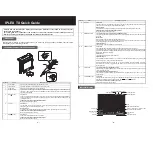
e) Press the CAL key again to confirm the value displayed. The µS (or mS)
symbol stops flashing. Rinse the probe with water. If measurements
are later made at low conductivity, we advise rinsing it in distilled
or, better, bidistilled water.
At this point the instrument is calibrated and ready for use.
TEMPERATURE COMPENSATION
The temperature coefficient
α
T
is the percentage measurement of the varia-
tion of conductivity with temperature and is expressed in %/°C (or %/°F).
The electric conductivity of a metal decreases as the temperature increases,
while it increases in a liquid. There therefore arises the problem that the
conductivity of two liquids cannot be directly compared if the measurement
has not been made at the same standard reference temperature, which in
chemical measurements is 20°C (25°C). If the measurement is taken at a
temperature different from 20°C (25°C), an approximate assessment of the
conductivity of the liquid at 20°C (25°C) may be obtained by means of tem-
perature compensation, defined by the following formula (see also fig. 3.1):
where:
= temperature expressed in °C
= conductivity at temperature
(°C)
20 = conductivity at 20°C (25°C)
α
T
20 = temperature coefficient expressed in %/°C
Unfortunately the formula does not give good results if the temperature is
appreciably different from 20°C (25°C) because
α
T
is not constant, but a
non-linear function of the temperature and the conductivity. Also, it is not
generally known before taking the measurement, unless it can be found on
tables referring to the liquid to be examined.
α
T
may be experimentally
determined by taking two measurements, one at 20°C (25°C) and another
at the temperature
, having previously excluded temperature compensa-
tion (in the HD 9213-R1 this may be done by setting
α
T
at 0.00, see the
next paragraph). The formula for calculating
α
T
is the following:
ENGLISH
– 38 –
=
20
α
T
100
1 +
(
- 20)
100
20
(
-
20)
α
T
x
=
- 20













































